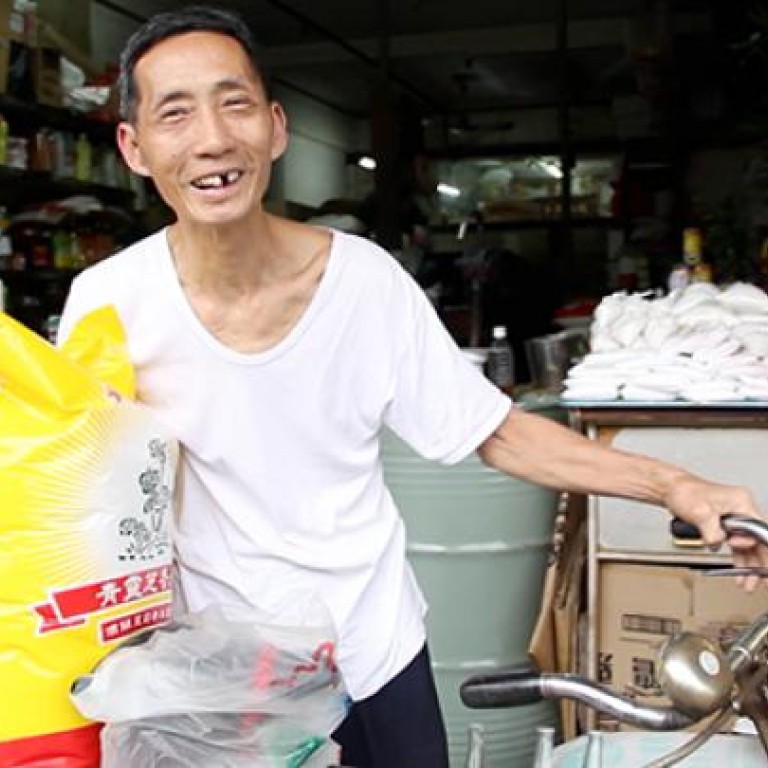
How calorie-counting and supermarkets are hitting Hong Kong's rice shops where it hurts
In this latest episode of our Uniquely Hong Kong series, a traditional rice shop owner laments how his business is declining in changing times, but argues it still has a vital role to play
Traditional rice shops are dying out in Hong Kong due to changing consumption habits among younger Chinese and competition from supermarkets, says Wong Tak-kam - owner of one of city's oldest rice shops.
The 68-year-old, who runs Shing Hing Tai Rice Shop, has been in business since 1970 - five years after his father first opened the shop in Shek Kip Mei.
Despite rice traditionally being the staple diet of southern China, rice shops in Hong Kong are struggling.
Wong says the shops still perform an important role offering quality rice to customers. He explains that a bag of rice is as unique as a cup of tea - each bag has its own flavour and character.
Wong also says his prices match those of supermarkets - although his shop has a wider selection.
"They [supermarkets] sell pre-packaged bags of rice which taste bland, because manufacturers follow a one-recipe-fits-all formula. There are also artificial colourings."
Consequently, Wong rarely visits supermarkets except to learn what his "competitors" are selling. He admits, however, that supermarkets are more convenient.
He says another reason for the decline in rice consumption - perhaps more than the advent of supermarkets - is today's obsession with slimming. "Women are afraid of eating carbohydrates, getting fat, and contracting diabetes." Wong shakes his head. "Rice can't be substituted. Rice is what makes us Chinese; the rice "qi" (or spirit) can't be replaced by noodles or bread," he stresses.
Preparing containers of rice for sale is something of an art. The rice "master" must understand how much old and new rice is to be mixed to maximise taste and quality. "Old" rice is more fragrant, and a year older than freshly harvested rice.
"Old rice used to be the norm when people were poorer in the 1970s," explains Wong. "It expanded more, so it could fill people's stomachs better. But it was also very hard. So, now, we add in newer rice. New rice is smaller and has smoother texture, so together, it's filling, fragrant, and settles better in the stomach."
There is also red, brown, and organic rice. Wong says these have become more popular in recent years, owing to today's increasingly health-conscious culture. The most popular brand comes from Thailand, but he also stocks rice from the United States, China and Vietnam. Other types include pearl and glutinous rice.
Wong is meticulous about quality. "If it's yellow, and smells bad... it's no good. Too old, and it'll be a mess when cooking. You want white and fragrant rice."
However, Wong says it has not been hard keeping up with trends. "I know people's tastes, so it's quite easy for me to know the proportions they want." He said this was true of all rice masters. They sit down with their customers and work out their preferences.
Once the rice master establishes the proportions of each type for an individual bag, he puts it into a rice-sifting machine. Wong's machine is as old as the shop itself, but still does a remarkably good job - dirt, sand, silt and even bugs are separated into a bucket.
After the rice is clean, it is bagged and stored until Wong makes home deliveries. He typically does this every 2-3 weeks, a far cry from the 1970s, when he made deliveries every other day. However, sometimes he gets more business. Recalling one incident 10 years ago, he says: "It was around the time of Leslie Cheung Kwok-wing's {death] and Sars. Everyone was scared there would be no more rice. So they stocked up."
He adds: "You can't keep rice for so long - it will go bad. Weevils will get in, and the rice will be inedible. And besides, if there's no rice, you can always eat something else." Then he quickly adds that rice, when available, should always be the first priority in Chinese food. "Rice isn't very nutritious, but it gives me a lot of power. That's why we rice masters can do such heavy labour," says Wong.
To demonstrate, he lifts three bags, in total 75kgs, onto his shoulders and jumps on his bike, to deliver his bags for the week. But Wong is pessimistic about the future. "Everyone is so old now," he says, referring to his contemporaries. "And no one wants to be in this business. It's physically taxing," he points to his hunched back, "And it doesn't pay well. When I retire, I'm just going to close my shop. No one is going to follow in my footsteps."
His wife jokes. "And our rice-sifting machine will go to a museum." Then, gesturing towards her husband, she adds: "even he's old enough to be a relic."

